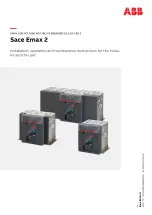
User Interface
20
The Protective LED indicates the operation of the protective
functions of the trip unit and blinks when operating properly.
This LED operates at current levels over 20% of the rated load
without external power, and at all current levels with external
power.
The Metering LED indicates the operation of the metering func-
tions of the trip unit and blinks when operating properly. Since
the metering function requires external power, this LED will not
light when the external power supply is not supplying power.
3.4.2
System Status LEDs
These two LEDs indicate the status of the breaker and associ-
ated power line. The Tripped LED is red and indicates a trip.
The Alarm LED is yellow and indicates an alarm condition.
These LEDs require the external power supply to be opera-
tional and supplying power.
The Tripped LED will light when the trip unit senses that the
breaker has tripped.
For more information about breaker monitoring, refer to the
breaker’s seperate information and instruction guide.
The Alarm LED will light when one of the alarm functions has
exceeded a limit set by the user. For more information about
Alarms, refer to
Chapter 6, Alarm Setpoints.
3.5
Idle Display Mode
When the SB Energy-Comm trip unit is on and left idle for five
minutes, the front panel display switches to idle display mode
and displays its configuration and metered data in real time.
Selecting
View Data
from the main menu also causes the trip
unit to enter idle display mode.
In idle display mode, the trip unit cycles through its metered
and configuration values until the operator presses a button on
the front panel. This cycling action allows the operator to see
information at a glance without having to use the keypad and
go through several menus to see the data.
Setting changes via the communications port is only allowed
when the trip unit is in idle display mode. This prevents con-
flicts between remote and front panel configuration.
The screens that display during idle display mode, in order, are
the Protection Configuration screen, the Metered Data screens
(the metered real-time values screen, and the metered energy
values screen), and the Demand Data screen. Examples of
these are shown below:
For more information on the protection settings, refer to
Chapter 5
.
For more information on the metered data, both real-time and
energy calculations, refer to
Chapter 8.
Chapter 8
also contains more information on the metered
demand data.
System
Status
Tripped
Alarm
















































